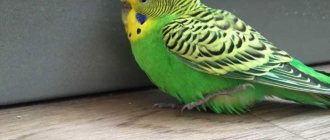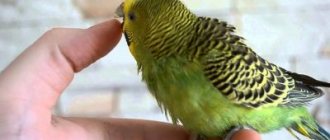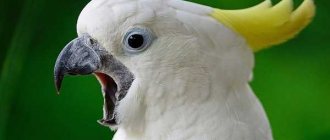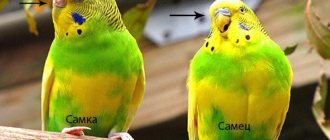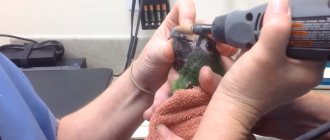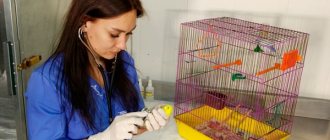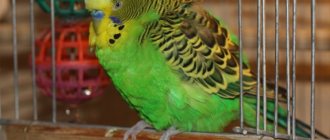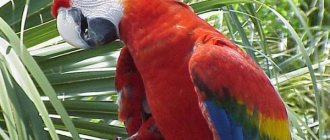A lot has been written about diseases of the paws of budgies, but each specific case must be dealt with separately. Bird owners are often left without practical help when it comes to treatment. Experiments with various drugs and methods of healing only aggravate the pathological process. The pelvic limbs of parrots bear the main load, and sometimes they cannot stand it. Let's talk about what kind of troubles happen to birds' feet and how to help your pet cope with the disease.
Problems with a parrot's legs
If the parrot is in good health and has healthy legs, it walks freely and jumps from perch to perch. While eating, it stands on one paw, and the other one holds a piece of fruit and pecks it. When he goes to bed or dozes, he tucks one limb under his abdomen and lets it rest.
Changed behavior may indicate that the parrot has pain in one leg:
- the bird often picks it up and fiddles with its beak;
- stops walking, tries to crawl;
- limps, cannot walk;
- trembles constantly;
- itches against surrounding objects, cage bars;
- falls from the perch during sleep and wakefulness.
Judging by the appearance of the pelvic limbs, it becomes clear that not everything is all right with the parrot:
- the skin takes on a strange shade and feels cold or hot to the touch;
- blood or ichor oozes from the leg;
- the epithelium peels off and grows, bumps appear;
- ulcers appear on the fingers;
- the joints swell, the paws differ noticeably in thickness from each other.
Next, we will consider several situations that cause the owner to worry about the pet’s paws.
In what cases should you contact a veterinarian?
Dermatitis is a rather insidious disease and can cause serious complications, so consultation with a specialist is required at a minimum. If the lesions begin to actively spread throughout the pet’s body, then a visit to the clinic is mandatory. Self-medication in such cases is unacceptable.
Only a doctor should prescribe antibiotics . In addition, not everyone can give bird injections on their own. In addition to the fact that specific syringes are needed here, you also need to know where exactly to inject.
Paws refused
Paralysis of the pelvic limbs occurs when there are disturbances in the functioning of the nervous system. If a parrot's leg fails, it looks pitiful: it tries to get up, but falls to the side and can only crawl, helping itself with its beak.
The parrot's legs gave out
This condition is caused by stress, severe bruises, and some illnesses. As an example, a concussion after a bird hits the glass. At first, the legs do not stop functioning, other symptoms appear:
- lack of coordination of movements;
- convulsions;
- lack of concentration;
- loss of consciousness.
On a note! Also, the limbs do not work in case of severe poisoning. If a parrot is frequently fed vitamin supplements, the substances accumulate in the body, causing muscle atrophy. It is difficult to neutralize intoxication, so you should not overuse fertilizing.
Causes
A complex of immunological reactions is most often caused by:
- Food;
- medicines;
- volatile allergens (pollen, chemicals, etc.);
- insect bites.
The disease may be non-allergic in nature. In this case, in addition to allergens, it is caused by: stress, infectious diseases, external factors (for example, hypothermia), intoxication of the body. Source: A. V. Lyapunov. Urticaria and Quincke's edema in children // Children's allergology. Ed. A.A. Baranova, I.I. Balabolkina. M.: GeotarMedia, 2006; 486-497.
Medicine also knows quite a lot of cases where the reason for such a reaction of the body has not been established.
Cold paws
If in its normal state the skin on the parrot’s paws is pinkish and slightly warm, then a bluish tint may signal that the bird is frozen. This is possible at the beginning of autumn, when the heating is not yet working. Ventilating the room and bathing the bird also causes a decrease in temperature. A parrot can also have cold feet due to stagnation of blood due to lack of movement.
Cold paws
First of all, you need to warm your ward: turn on the ultraviolet lamp next to the cage, pick up the pet or simply let it fly. If this is a temporary phenomenon, the temperature will soon return to normal.
You should start to worry if additional symptoms appear: loose stools, refusal to eat, general weakness, “taciturnity.” Poisoning or a viral disease may be suspected. You should seek help from a veterinarian.
Quincke's edema in children
- Symptoms of the disease
- How does Quincke's edema begin in a child?
- Causes
- First aid
- Treatment of Quincke's edema in children
Attacks most often occur in children with urticaria. Pediatricians associate swelling with hay fever, bronchial asthma, and atopic dermatitis.
Important! This is a dangerous condition, which in a quarter of cases provokes swelling of the larynx.
Quincke's edema occurs in newborns and older children. Its nature is most often allergic, but this phenomenon can be hereditary and also have no clear origin. Source: I.I. Balabolkin. Urticaria and angioedema in children // Pediatrics, 2009, v. 87, no. 2
The prognosis is usually favorable; it becomes poor with frequent relapses and associated swelling of the internal organs and larynx. The consequences may be anaphylactic shock, bronchospasm.
For prevention, in some cases vaccination is carried out. Its necessity is determined individually. Clinical recommendations for parents: provide the child with a low-allergen diet, take antihistamines at intervals recommended by the doctor, minimal or no contact with the allergen.
Hot paws
The legs overheat if the pet moves actively. A parrot's paws become hot if it intends to attack an opponent, peck its owner, or grab a tasty morsel. It depends on your temperament. In sluggish, boring individuals, the limbs are almost never hot.
You can talk about pathology if certain areas of the paws are much warmer. Typically, with joint diseases, the affected areas are hot, while the remaining areas are at normal or slightly lower temperatures. When a bird feels bad, it sits lower on the crossbar and spreads its legs wide.
This is interesting! A bird’s body temperature is 2–4 degrees higher than a human’s, so out of habit it seems to us that the parrot has hyperthermia. An electronic thermometer will help you cope with panic: you need to record several indicators during the day to make sure the bird is healthy.
First aid
call an ambulance immediately . Doctors may decide on emergency hospitalization if the patient has difficulty breathing, a swollen tongue, or symptoms indicating intestinal damage.
What to do before the doctors arrive?
First aid, which should be provided at the first symptoms of angioedema in children, involves clearing the airways, checking breathing intensity, heart rate, and blood pressure. Sometimes it is necessary to perform cardiopulmonary resuscitation, so after the first case, parents are recommended to take first aid courses. At the final stage, medications should be administered to the child.
First aid equipment includes:
- glucocorticosteroids (“Prednisolone”, “Dexamethasone”);
- antihistamines;
- adrenalin.
Sequence of administration: adrenaline, then glucocorticosteroid, then antihistamine. If the reaction is moderate, then adrenaline is excluded.
| Adrenalin | It is injected intramuscularly into the thigh (middle third outside) at the rate of 0.01 mg for each kg of the child’s weight. If there is no effect, then the injections are repeated every 15 minutes. |
| Glucocorticosteroids | Injected intramuscularly into the buttock or intravenously. You can pour the medicine from the ampoule under the tongue - this way the effect will come faster. The dosage of Prednisolone is from 60 to 150 mg, Dexamethasone is from 8 to 32 mg. |
| Antihistamine | Intramuscular injection is preferable. It is possible to take a pill, but the effect will come later. The dosage depends on the medicine. For example, “Loratadine” – 10 mg, “Cetrizine” – 20 mg. |
Important! In case of swelling of the larynx, a tracheostomy is performed urgently.
The bird presses its paw
When a parrot tucks one leg, it is probably resting. It is difficult for birds to constantly move, stand and sit with support on two limbs, so they relieve them one by one from the load. But this can only be said with confidence about those birds that always behave this way.
Changed habits may indicate that the parrot is experiencing discomfort. If he is used to sleeping sitting on both legs, but now pulls one of them under himself, he may be in pain. Sometimes discomfort is caused by improperly sized perches. Remove the thin plastic bars from the cage and secure natural, untreated branches in it. Inspect and feel the limb being protected. If you notice a wound, swelling, growths or ulcers, take your bird to the veterinarian.
Blue is the normal color of the paws
An unusual shade of the lower limbs is observed in almost all parrots at birth. Immediately after hatching from a budgerigar egg, the baby's legs have a light blue tint. As it ages, it may darken and turn black or brown. But in some cases, the blue color remains for life. In such birds, similar shades also prevail in the color of the plumage.
It's normal for a budgerigar to have blue feet.
Growths, peeling
Every parrot develops tumors on its legs at least once in its life. Ugly growths are a consequence of processes in the skin caused by the activity of parasites. A common infectious disease among birds is knemidocoptic mange, a scabies mite.
Microorganisms colonize unfeathered areas of the skin, make passages in them, feed on particles of the epithelium and secrete their waste products inside. Moving in the skin, the scabies mite causes unbearable itching; the bird constantly itches and pecks at the metatarsus. The skin becomes loose, peels, and the surface layer crumbles.
Growths on the paws
Treatment for scabies is simple, but long-term. The affected paws of the parrot are treated with aversectin ointment according to a special scheme. Unfortunately, recovery does not guarantee that the parrot will not contract the disease again in the future. Ticks are carried on tree branches and used equipment. You can become infected from other birds if quarantine is not observed.
On a note! Growths on the paws appear not only with knemidocoptosis. Excess calcium causes calcareous deposits on the metatarsals in the form of plates. You can cope with this problem by adjusting your diet.
Prices
| Name of service (price list incomplete) | Price |
| Appointment (examination, consultation) with an allergist-immunologist, primary, therapeutic and diagnostic, outpatient | 1750 rub. |
| Prescription of treatment regimen (for up to 1 month) | 1800 rub. |
| Consultation (interpretation) with analyzes from third parties | 2250 rub. |
| Consultation with a candidate of medical sciences | 2500 rub. |
| Allergen-specific immunotherapy (ASIT) - maintenance course (excluding the cost of the drug) | 8100 rub. |
Diseases and injuries of paws - how to treat
Birds can repeatedly injure their fragile limbs throughout their lives, as they bear increased stress. If one foot does not work, the second one must take on double duty. In addition to problems in everyday life, parrots have congenital pathologies: lack of fingers, congenital dislocations, calcium deficiency.
Causes of foot diseases in parrots:
- lack of movement;
- poor living conditions;
- poor nutrition;
- poor quality equipment;
- hereditary factors.
Not only poor health and living conditions affect the condition of the paws: even in a peaceful home environment, dangers lurk for a parrot. A pet released outside the cage seems to be trying to fall into a trap. But traumatic situations can also happen in a cage, especially if several birds are kept together.
Birth defects
Often parrots are born with pathologies of the limbs. This is due to impaired embryo development and genetics. The deformities of the chicks originate in the way their parents were kept. Poor diet, unsanitary conditions, poor care - all these factors weaken the birds’ bodies before the nesting season. The hidden reason is inbreeding. Physical disabilities can be in the form of fewer or more fingers, missing limbs, or crooked bones. Some deviations can be corrected surgically.
Mechanical damage
Ornamental parrots are fragile birds, they can get injured very easily:
- fracture;
- dislocation;
- stretching;
- injury;
- a cut;
- burn;
- claw separation.
Dislocation of the paw
The most traumatic situations occur when the bird is on a walk. He can catch his claw on textiles or upholstered furniture, jerk and dislocate his paw. Or sit on a hot stove or kettle and get burned. Sharp fasteners, knives left in a visible place, untreated fittings are the causes of cuts.
Parrots love to sit on doors, risking being crushed. Fractures of paws and fingers mainly occur due to the carelessness of the owners. A bruised or twisted limb swells and acquires a bluish tint. The bird protects her and does not rely on her. Overgrown claws tend to break off at the wrong time and cause severe pain to the bird.
Important point! It is necessary to monitor the length of the claws: do not file, but trim off the extra millimeters. It is comfortable for a parrot with well-groomed claws to sit on a perch and walk on soft surfaces.
If your parrot has injured its leg, remember what to do and what measures need to be taken immediately:
- Sprains and bruises are lubricated with a cooling, pain-relieving gel, and compresses are made.
- The dislocation is reduced and secured with a bandage.
- A splint is applied to the broken leg. Mineral components are added to the feed. The fracture takes at least two weeks to heal.
- The burn is treated with an oil solution of vitamin A.
Deep damage causes tissue necrosis. Limbs may soon be amputated.
Ulcers (nasties)
Domestic parrots are forced to sit in cages a lot. Perches that are thin or thick, slippery or plastic, make it difficult for birds to get a good grip on them. As a result, bedsores and calluses appear on certain areas of the soles.
The limb becomes covered with ulcers, swells, and becomes hot. The parrot presses its sore paw, frantically pecking at the inflamed skin. If help is not provided on time, the process worsens and pus leaks from the ulcers. The feathered pet can no longer stand; it lies down on its stomach.
The simplest remedy for treating namins is soda. Warm baths and lotions soften tissues and remove the contents of ulcers. The treatment includes retinol for skin treatment, Traumeel and hydrocortisone. After removing the pus, apply a bandage with a wound-healing drug to the paw and change it every 2 to 3 days.
For the purpose of prevention, all inappropriate accessories are removed from the cage: swings, ladders, perches. Plastic additives are replaced with wooden ones wrapped in jute. The diameter of the perch should correspond to the grip of the fingers: for a budgerigar it is 1.5 - 2.5 cm. In addition to changing equipment, you need to organize daily walks so that the bird moves more and trains its feet.
Gout
If there is a metabolic disorder in the parrot's body, uric acid accumulates and gout occurs. This is an incurable disease that often goes unnoticed in a chronic form. At an early stage, diagnosis is difficult, since there may be no symptoms or they may be similar to signs of other diseases.
Gout in a parrot
How does gout manifest?
- The bird's food preferences change. Appetite and thirst increase.
- The droppings become liquefied, but the color remains the same. After some time, the discharge becomes completely liquid.
- When a parrot's leg hurts, it is impossible not to notice - it begins to limp. Fingers are a little red.
- Nodules with white contents form in the joint area. Salt deposits gradually increase and cover large areas.
- In the advanced form of the disease, the joints become clogged with uric acid salts, and the parrot cannot bend its fingers and stay on the perch.
In the first days, surgery helps a lot: you need to pierce the skin with a disinfected needle and squeeze out the contents. If the disease is not detected immediately, the fluid can no longer be removed. It is necessary to put your pet on a strict diet: exclude animal products, add fresh herbs and branches. Veterinarians prescribe methenamine, salicylic acid, and colchicine.
Gangrene
In parrots, after damage to their paws, burns or frostbite, gangrene - tissue necrosis - can occur. This usually happens when the wound becomes infected or the blood circulation is impaired. The first sign of gangrene is a change in the color of the limb. In normal condition, the skin is light and transparent, yellow or gray. As the tissues die, their color gradually changes from burgundy to black.
Gangrene in a parrot
The parrot's leg no longer moves and he is in severe pain. The limb ceases to function. With a favorable set of circumstances and timely treatment, the paw can be saved. True, the fingers and their phalanges are partially broken off, and the bird itself gnaws them off. If the necrosis process does not stop, the limb must be amputated.
Attention! If a parrot is ringed, as it grows the ring may become tight and cut into its paw. This also happens after fractures and joint damage. The injured limb swells, the area below the ring turns blue and dies. To prevent this from happening, the ring must be cut using special scissors.
Arthritis
Inflammation of the joints can be triggered by pathological factors - infection with microorganisms: streptococcus, staphylococcus.
Or physiological:
- lack of movement due to crowded living of several individuals in one cage;
- impaired blood supply to the extremities;
- excess weight of the bird;
- an uncomfortable perch, sitting on which the parrot cannot evenly distribute its weight.
The problem joint swells, becomes purple and hot. The parrot's leg hurts a lot, he is gnawing on it. With an open wound there is a risk of secondary infection. The disease progresses rapidly, especially in birds with weak immunity or poor lifestyle and nutrition. In severe cases, death is possible.
The diagnosis is made based on a blood test. Treatment usually includes antibiotics if the origin of the disease is bacterial. To eliminate ulcers, medications that contain regenerating components are suitable.
Symptoms of the disease
The reaction develops rapidly; signs of angioedema in children are swollen lips, neck, and face. The upper torso, hands, feet, and genital area are often affected. Quincke's edema is visible in the eyes of a child - the eyelids swell on one or both sides.
- When the tonsils are affected, the picture is similar to a sore throat.
- Edema of the larynx is indicated by a hoarse voice, difficulty breathing, a gusty cough, blue discoloration and then gradual paleness of the skin.
- Swelling that appears in one area may occur in another. This mainly applies to large-scale swelling.
- When the mouth and tongue swell, speech becomes difficult.
- If the process is localized in the gastrointestinal tract, the child may complain of tingling of the tongue, followed by diarrhea and vomiting, and sharp pain in the intestinal area.
- Rarely, swelling of the meninges occurs. With it, the child cannot fully tilt his head forward, complains of a headache, and behaves inhibited. Convulsions and vomiting may occur.
- If only the skin is affected, joint pain, fever may appear, and the child may lose consciousness.
The pathological condition can last from an hour to several days.
How does angioedema begin in a child?
Immediately after contact with the allergen, the listed symptoms increase sharply. This happens in a matter of minutes. Source: G. I. Smirnova. Urticaria and Quincke's edema // Allergic diseases in children. Ed. M.Ya. Studenikina, I.I. Balabolkina. M.: Medicine, 1998: 279-287 If you press on the swollen area, the child will not experience pain, but you will feel a dense swelling, on which, after pressing, there will be no characteristic depression.
Parrot chews its paws
The owner should be wary if the pet begins to behave in an unusual way. Just because a bird is chewing on its feet does not always mean there is a problem. The parrot can press its paws and frantically peck at the skin until wounds appear. If at the same time he often scratches himself and screams, you should sound the alarm. Associated troubles: lack of appetite and sleep, loss of interest in communication and toys, constant nervousness.
Biting paws is sometimes an indicator of stress. Some parrots cannot get rid of this habit throughout their lives. If it does not cause injury, leave the bird alone. Try changing your pet's diet: add vitamins and minerals, regularly provide fresh branches and herbs, pamper him with treats.
Can birds have diathesis?
All warm-blooded animals, including birds, face similar problems. Due to their small size and low weight, budgerigars are especially difficult to tolerate the disease. In its natural habitat, dermatitis develops much less frequently, because the bird receives the entire necessary set of nutrients, and natural ones at that.
At home the situation is different. Here there is a different microclimate, industrial feed and mistakes by the owner in caring for the pet. Birds kept in cages suffer from dermatitis more often, but problems with the skin can be avoided if this issue is thoroughly studied.
Stomping his paws on the floor
No matter how strange it may sound, parrots can also stomp their paws, like other pets. It looks a little ridiculous: the bird stands still and suddenly jumps up, stamping with one paw. It can be assumed that she is bothered by discomfort in her limbs and is trying to get rid of it. Most likely, this behavior is caused by parasites living on the skin and feathers.
Carry out a thorough examination of your pet: examine the space between the feathers, touch the skin on the wax, pay attention to the cloaca, eyes and beak. Check the length of the nails to see if it's time to trim them. If you don't notice anything suspicious, perhaps the bird is just playing like that.
Diseases and injuries to the paws are serious troubles, due to which the quality of life of a parrot is noticeably reduced. It is important to respond to pathological changes in a timely manner and not to forget about the basic rules of bird care.
Treatment of angioedema in children
- stopping contact with the allergen;
- removal of the allergen from the body (sorbents, drinking plenty of fluids);
- the use of antihistamines, glucocorticosteroids, diuretics and other drugs, depending on individual indications.
The treatment plan may vary and include other interventions and complex drug therapy. It depends on the type of disease, the number of relapses and other factors. It is necessary to obtain specialist advice.
Sources:
- I.I. Balabolkin. Urticaria and angioedema in children // Pediatrics, 2009, v. 87, no. 2.
- G. I. Smirnova. Urticaria and Quincke's edema // Allergic diseases in children. Ed. M.Ya. Studenikina, I.I. Balabolkina. M.: Medicine, 1998: 279-287.
- A. V. Lyapunov. Urticaria and Quincke's edema in children // Children's allergology. Ed. A.A. Baranova, I.I. Balabolkina. M.: GeotarMedia, 2006; 486-497.
Grek Elena Anatolyevna Clinic
Author of the article
Grek Elena Anatolyevna
Doctor of the highest qualification category
Specialty: allergist
Experience: 23 years
The information in this article is provided for reference purposes and does not replace advice from a qualified professional. Don't self-medicate! At the first signs of illness, you should consult a doctor.
Treatment of paws for kidney disease
Kidney disease can be identified based on delayed color changes, lack of appetite. Chills and symptoms of pain are sometimes observed.
Vigosin is used for treatment, it is added in a ratio of 0.2 ml per 100 ml of water for 10 days. This drug is sold at a veterinary pharmacy. In addition to treating the kidneys, it works generally on the bird's body.
A prerequisite for effective treatment is to stick to the dietary regimen. I excluded all protein foods - cottage cheese, eggs. Water is supplied only purified from a pharmacy or store. It must be unmotorized and without gas.
When the bird's condition improves, you can massage your fingers and help with muscle exercises. For the exercises, a pencil with a fascia and a rough stick is used, which fits over the bird's fingers and moves it.
How to solve the problem of poor nutrition
Serious irregularities are much less common than ordinary nutritional deficiencies. At the first sign of poor well-being, change your food for the better. Sometimes you need to buy more than one package until the animal knows what karma tastes and fits. From domestic producers there is a good opinion about the food “Rio” and “Lyubimchik.
If parrots are losing their legs, there may be a calcium deficiency or this mineral is poorly absorbed due to a lack of vitamin D. You can help the bird by giving it calcium gluconate and a B vitamin to its beak. Special vitamin complexes are sold at the veterinary pharmacy:
The preparation chosen must contain vitamin D. This is given for two weeks by adding it to water or grain. Between successful courses of treatment it is necessary to take a 60-day break.
Prevention of mechanical trauma to the paws and muscle atrophy
Small fearless bird, parrot, easy to hand. It sits on the arm, shoulder or head of its owner. Maybe, at the most inopportune moment, a nest to an open closet or internal doors. In the apartment, move carefully and do not swing the door with open doors, this is a safety principle that the birds' paws remain undamaged.
If there is a cat or dog in the apartment, the parrot will certainly try to contact them. Not all pets will be able to appreciate his efforts. Poor communication can end up breaking birds' legs and wings. Therefore, it is recommended not to leave your bird alone without a cage with cats, dogs, ferrets and other predators.
But continuous sticking in a tight cage is also not good for the bird. The bird may become ill due to impaired circulation. The muscles disappear, the parrot loses its appetite and quickly dies.
The cause of foot injuries may be long claws that will cling to various objects. This problem can be easily solved. The claws should be trimmed with special pliers once every 2-3 months, observing the light of the capillaries so as not to damage them.

